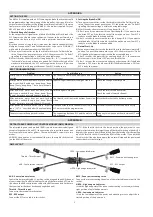
8
ergonomic carrying comfort and ease of use with the original X-load transfer system, which
offers a better distribution of the weight.
The rucksack should be packed carefully to achieve maximum comfort. First, place the glider
inside the harness and then put the top of harness in the bottom of the rucksack with the glider
side next to the back of the rucksack. Finally, tighten the internal and external compression
straps and adjust the shoulder and waist straps to ensure the equipment stays firmly in place
when walking. There are also two storage pockets for accessories.
An XXL rucksack is available as an optional extra for pilots that require it.
Your harness
The Boomerang9 is certified for use with all harnesses with variable cross-bracing (GH type).
Practically all modern harnesses are GH type harnesses. Older harnesses with fixed cross-
bracing (GX type) are not certified and should not be used. Check with the manufacturer of the
harness or your paragliding instructor if in doubt whether your harness is a GH or GX type
harness.
The adjustment of the harness chest strap controls the distance between karabiners and affects
the handling and stability of the glider. Excessive tightening the chest strap increases stability
but also the risk of twists following glider collapse, and it also increases the frequency of
getting collapses due to poor feedback from the glider. The risk of twisting is also strongly
affected by the seating position of pilot. Flying in a laid back (reclined) position makes it much
more difficult to react in time to prevent riser twisting. With the chest strap in a more closed
position the glider also has more tendency to maintain a stable spiral, lengthening of the chest
strap gives more feedback from the glider but decreases stability.
Gin calculates and draws the plan of the glider with a distance between the carabiners of 44cm.
DHV certification test flights are also carried out with this setting. We recommend setting a
distance of 42cm to 50cm between the carabiners, depending on the size and design of the
harness. There is no need to fly with a tight chest strap setting with the Boomerang9, as there
is no tendency for it to feel unstable, unlike older gliders.
Certified Weight Range
The Boomerang9 must be flown within the certified weight range given in the reference section
of this manual. The weight range is quoted as the total weight in flight, i.e. the weight of the
pilot, glider, harness and accessories. The easiest way to check your total weight is to stand on
weighing scales with all your equipment packed into your rucksack.
Summary of Contents for Boomerang 9
Page 20: ...20 Line Plan...







































